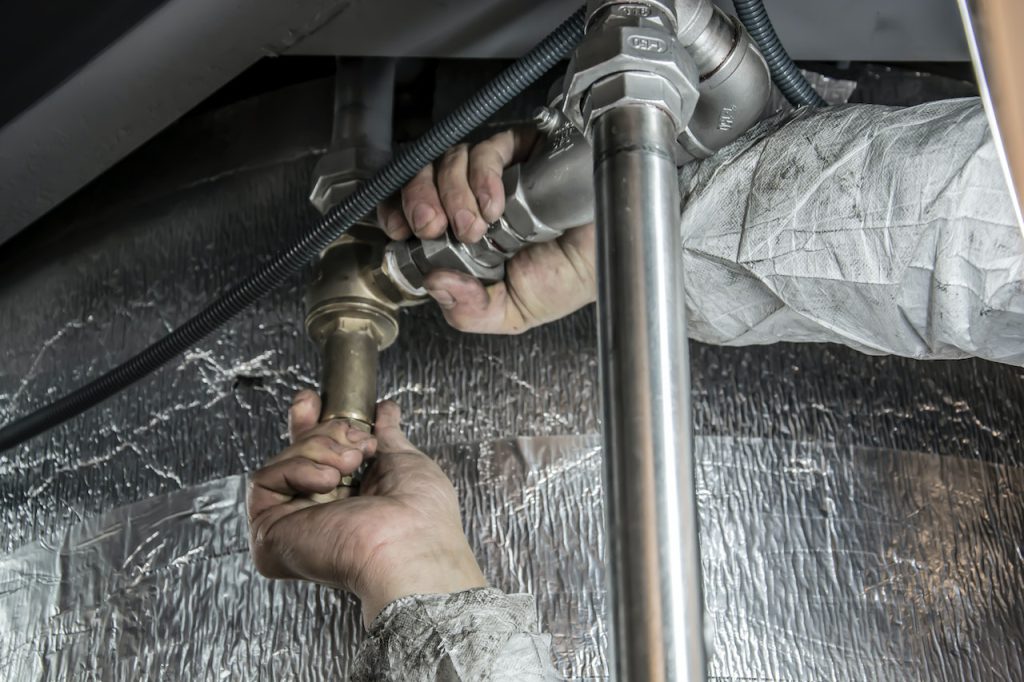Discover how mold growth in your plumbing system can impact your well-being. Mold thrives in damp environments, such as leaky pipes or poorly ventilated areas, releasing spores that can trigger respiratory issues and allergies. The presence of mold in your plumbing may lead to health concerns like coughing, wheezing, or skin irritation. Addressing mold promptly is crucial to prevent its negative effects on your health. Stay informed about the risks associated with mold growth in your plumbing system to safeguard your family’s health and well-being.
Table of Contents
ToggleUnderstanding Mold Basics
Common Types
Mold is a type of fungus that can grow in different places around your home, especially in areas where there is moisture. Some common types of mold that you may find in your house are Aspergillus, Cladosporium, and Stachybotrys. These molds like to hang out in places that are damp and humid, such as bathrooms and kitchens. When mold starts to grow in your plumbing system, it can release tiny spores into the air that you breathe. Breathing in these mold spores can sometimes cause health problems, especially for people who have allergies or asthma. It’s important to keep an eye out for any signs of mold growth in your plumbing system and take steps to get rid of it to keep yourself and your family healthy.
Growth Conditions
One kind of fungus that thrives in warm, humid environments is mold. Mold can find the ideal circumstances in your plumbing system to grow and proliferate. Three essential elements are needed for mold to grow: organic matter, warmth, and moisture. These circumstances can readily be satisfied by your plumbing system, particularly if there are leaks or excessive humidity levels. Mold can thrive in moist environments created by leaks in pipes, and it can also feed on organic materials like soap scum or dirt! Therefore, it’s critical to monitor your plumbing system and quickly address any leaks to stop mold from growing. Keep in mind that being healthy internally starts with your plumbing system.
Prompt Addressing
When mold starts to grow in your plumbing system, it can release tiny particles called spores into the air. These spores can be harmful when inhaled, especially for people with allergies or asthma. Mold can also produce mycotoxins, which are toxic substances that can cause various health problems when exposed to them for a long time. Some common symptoms of mold exposure include coughing, sneezing, watery eyes, and skin irritation. In severe cases, mold exposure can even trigger asthma attacks or worsen existing respiratory conditions. Therefore, it’s essential to address any signs of mold growth in your plumbing system promptly to protect your health and well-being.
Mold in Buildings: A Common Issue
Prevalence of Mold Issues
Mold in buildings is a common issue, often lurking in damp, dark areas like basements and bathrooms. It thrives in moist environments, making buildings with plumbing problems particularly vulnerable.
Mold spores are microscopic and float through the air, easily finding their way into buildings through open windows or HVAC systems. Once inside, they settle on surfaces like walls, ceilings, and pipes, initiating mold growth.
Spread of Mold Within Buildings
When mold finds a damp spot to settle, it begins to grow rapidly. Spreading through the release of spores, mold can quickly colonize different areas within a building. As it multiplies, it forms unsightly patches and releases musty odors.
In addition to visible signs, mold can also grow behind walls or ceilings where it remains hidden but continues to spread. This hidden growth poses a challenge for detection and eradication efforts.
How Mold Growth in Your Plumbing System Can Affect Your Health
Mold growth in plumbing systems can pose significant health risks to individuals exposed to it. Understanding these risks is essential for maintaining a healthy living environment. Here are some of the key health risks associated with mold in plumbing:
- Respiratory Issues:
Mold spores released into the air can be inhaled by occupants of a building, leading to various respiratory problems, especially for individuals with pre-existing conditions like allergies or asthma.
- Allergies: Mold is a common allergen that can trigger allergic reactions in sensitive individuals. Symptoms may include sneezing, coughing, nasal congestion, itchy eyes, and throat irritation. Prolonged exposure to mold can exacerbate these symptoms and cause discomfort.
- Asthma: For people with asthma, exposure to mold spores can worsen their condition. Mold can act as an asthma trigger, leading to symptoms such as wheezing, shortness of breath, chest tightness, and asthma attacks. Managing indoor air quality is crucial for asthma management, and mold control is a key aspect of that.
- Skin Irritation and Allergic Reactions:
Mold can also cause skin problems upon direct contact or exposure to mold-contaminated surfaces. This is particularly concerning in areas where moisture promotes mold growth, such as bathrooms and kitchens.
- Contact Dermatitis: Direct contact with mold or surfaces contaminated with mold can cause contact dermatitis. Symptoms may include redness, itching, rash, and sometimes blistering of the skin. Continuous exposure can lead to chronic skin issues.
- Allergic Skin Reactions: Some individuals may experience allergic skin reactions when exposed to mold. This can manifest as hives, eczema flare-ups, or other forms of allergic dermatitis. Sensitivity to mold can vary among individuals, with some being more prone to skin reactions than others.
- Potential for Mycotoxin Exposure:
Certain molds produce mycotoxins, which are toxic compounds that can have serious health effects on humans and animals. While not all molds produce mycotoxins, the presence of these toxins amplifies the health risks associated with mold exposure.
- Health Effects: Mycotoxin exposure can lead to a range of health problems, depending on the type and amount of mycotoxins present. These effects can include neurological symptoms like headaches, dizziness, memory problems, respiratory issues, immune system suppression, gastrointestinal disturbances, and in severe cases, organ damage.
- Long-Term Exposure: Chronic exposure to mycotoxins, even at low levels, has been linked to persistent health issues and can contribute to the development of respiratory conditions, allergies, and other systemic health problems over time.
It’s important to note that vulnerable populations, such as infants, elderly individuals, pregnant women, and those with compromised immune systems, may be more susceptible to the health risks associated with mold exposure. Therefore, addressing mold growth in plumbing systems promptly and implementing preventive measures is crucial for maintaining indoor air quality and safeguarding health. Regular inspections, moisture control, proper ventilation, and prompt remediation of water leaks or mold growth are essential practices for minimizing these health risks.
Importance of Addressing Mold
Addressing mold growth in your plumbing system is essential for maintaining good health. Mold not only affects indoor air quality but also poses risks to overall well-being. Regular inspection and maintenance of plumbing systems can help prevent mold growth.
Detecting Mold in Your Plumbing
Common Signs
A musty smell is one of the common signs indicating mold growth in your plumbing system. If you detect a musty odor coming from your sinks or drains, it could be a sign of mold presence. Another indicator is visible dark spots or patches on walls near plumbing fixtures.
Hidden Areas
Mold can develop in hidden areas within your plumbing system, such as behind walls or under floors. These concealed spaces provide the ideal environment for mold growth due to moisture accumulation, often unnoticed until the issue becomes severe.
Early Detection Tips
Regularly inspecting your plumbing system can help you detect mold early. Use your sense of smell, especially around damp areas, to identify any musty odors. Check for any visible signs of mold, such as discoloration or spots, and address them promptly.
High-Risk Groups for Mold Effects
Susceptible Individuals
Certain individuals, such as children, elderly people, and pregnant women, are more susceptible to health problems from mold exposure. Their weaker immune systems make them vulnerable to the adverse effects of mold spores in the environment.
Allergies and Immune Suppression
People with allergies or immune system suppression are at a higher risk of experiencing health issues due to mold growth in their plumbing systems. Allergic reactions can be triggered by inhaling or coming into contact with mold spores, leading to respiratory problems.
Underlying Lung Diseases
Individuals with underlying lung diseases, such as asthma or chronic obstructive pulmonary disease (COPD), need to be cautious about mold exposure in their plumbing system. Mold spores can exacerbate their existing respiratory conditions, leading to severe symptoms and complications.
Preventing Mold in Homes and Buildings
Controlling Moisture
Excess moisture in homes can lead to mold growth, especially in areas like bathrooms and kitchens. To prevent this, ensure proper ventilation to reduce humidity levels.
Maintain a dry environment by promptly fixing any leaks in plumbing fixtures or roofs. Use exhaust fans while cooking or showering to decrease moisture buildup. By controlling moisture levels, you can effectively inhibit mold growth.
Importance of Ventilation
Proper ventilation plays a crucial role in preventing mold formation indoors. It helps in circulating fresh air and reducing humidity, creating an inhospitable environment for mold spores to thrive.
Ensure that your home has adequate ventilation systems in place, especially in high-moisture areas like bathrooms and basements. Good airflow not only improves indoor air quality but also discourages mold growth.
Regular Cleaning and Maintenance
Regularly inspect areas prone to moisture accumulation, such as under sinks or around windows, for any signs of water damage. Promptly address any issues to prevent mold from taking hold.
Clean and disinfect surfaces using solutions like bleach to kill existing mold spores and prevent further growth. Consider using dehumidifiers in damp areas to maintain optimal humidity levels.
Remediation Strategies for Mold
Effective Methods
Treatment of mold growth in your plumbing system can be achieved through various effective methods. One common approach is using a mixture of water and detergent to scrub the affected surfaces. This helps in physically removing the mold from the surface. bleach can be used on non-porous surfaces to kill mold spores.
To further ensure thorough removal, vacuuming with a HEPA filter can be beneficial in capturing any loose spores. After cleaning, it’s crucial to dry the area completely to prevent further mold growth. Proper ventilation is key in aiding the drying process and reducing humidity levels that promote mold development.
Importance of Thorough Cleaning
Thorough cleaning is essential not only for immediate removal but also to prevent mold recurrence. By addressing the root cause of moisture, such as fixing leaks or improving ventilation, you can significantly reduce the likelihood of mold regrowth. Regular inspections of plumbing systems and prompt repairs are crucial steps in maintaining a mold-free environment.
Furthermore, implementing preventive measures like using exhaust fans in bathrooms and kitchens can help reduce moisture levels in these areas. Regular maintenance of plumbing fixtures and pipes can also contribute to the early detection of leaks, preventing extensive mold growth.
Professional Help
While DIY methods can be effective for minor mold issues, there are instances where seeking professional help for mold remediation is necessary. If the affected area is large or if there is significant water damage involved, professionals have the expertise and equipment to handle the situation effectively. They can conduct thorough inspections, identify hidden mold growth, and provide comprehensive remediation solutions.
Professional mold remediation services may include advanced techniques such as air filtration devices and specialized cleaning agents that ensure complete eradication of mold. Moreover, experts can offer guidance on long-term prevention strategies to safeguard your plumbing system against future mold infestations.
Professional Mold Testing and Interpretation
Benefits
Professional mold testing offers precise identification of mold types present in your plumbing system. Experts utilize specialized equipment to detect hidden mold growth accurately.
Engaging professionals for mold testing ensures thorough inspection, identifying specific types of molds that may pose health risks. This detailed analysis aids in implementing effective remediation strategies.
Interpretation
Experts interpret results from mold tests, providing insights into the severity of contamination. They analyze the type and concentration of molds present, determining potential health hazards.
Professionals offer detailed reports on mold test results, outlining actionable steps to address the issue. Their expertise enables them to recommend appropriate measures for mold removal and prevention.
Importance
Consulting experts for mold testing and interpretation is crucial for accurate assessment of mold contamination. Their knowledge helps in understanding the implications of mold growth on health and property.
Expert guidance ensures that necessary actions are taken promptly to mitigate health risks associated with mold exposure. Professionals provide tailored solutions based on the specific type of mold detected.
Closing Thoughts
In understanding mold growth in plumbing systems and its impact on health, it becomes evident that prevention and early detection are paramount. Regular inspection, maintenance, and prompt remediation can significantly reduce the risks associated with mold exposure. High-risk groups, such as individuals with respiratory conditions or compromised immune systems, should be particularly vigilant in monitoring and addressing any signs of mold growth in their living spaces.
To safeguard your health and well-being, take proactive steps to prevent mold proliferation in your plumbing. Stay informed about the signs of mold presence, invest in professional testing when needed, and prioritize swift remediation measures. By being diligent in maintaining a mold-free environment, you not only protect yourself but also create a healthier living space for yourself and your loved ones.
Frequently Asked Questions
1. Is mold growth in the plumbing system a common issue in households?
Mold growth in plumbing systems is a common issue due to moisture buildup. Leaks or poor ventilation can promote mold growth, affecting indoor air quality and potentially causing health issues.
2. How can mold growth in the plumbing system affect one’s health?
Mold in plumbing systems can release spores into the air, leading to respiratory problems, allergies, and other health issues. Individuals with compromised immune systems or respiratory conditions are particularly at risk.
3. What are some signs of mold presence in a plumbing system?
Signs of mold in plumbing include musty odors, visible mold growth on pipes or walls, water stains, and an increase in allergy symptoms among occupants. Prompt action is crucial upon noticing these signs.
4. How can high-risk groups protect themselves from the effects of mold in plumbing?
High-risk groups such as children, the elderly, and individuals with respiratory conditions should ensure proper ventilation, address leaks promptly, and consider regular inspections to prevent mold growth and its associated health risks.
5. Are professional mold testing services necessary for detecting mold in plumbing systems?
Professional mold testing is recommended for the accurate detection of mold in plumbing systems. Trained professionals use specialized equipment to identify hidden mold growth and provide insights for effective remediation strategies.
Explore Unmatched Solutions for Mold Growth in Plumbing Systems with Garcia Plumbing and Home Restoration!
At Garcia Plumbing and Home Restoration, we recognize the distress and inconvenience caused by unexpected mold growth in your plumbing system. Renowned for our expertise in promptly and effectively addressing mold growth issues, our team is dedicated to restoring the integrity and cleanliness of your home’s plumbing infrastructure.
Our commitment at Garcia Plumbing and Home Restoration goes beyond mere problem-solving; we prioritize ensuring the long-term reliability and efficiency of your plumbing. With an outstanding reputation in Contra Costa County, we are renowned for our unwavering commitment to quality, our comprehensive understanding of plumbing challenges, and the trust we have earned from numerous satisfied clients. Don’t let the worry of mold growth disrupt the tranquility of your home. Contact us today for premier mold growth solutions and regain the comfort and safety of a fully functioning plumbing system!




